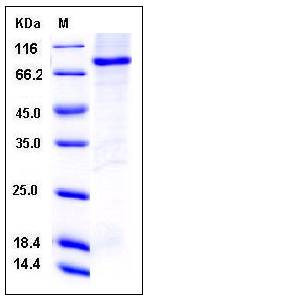Human DYRK3 / REDK Protein (His & GST Tag)
DYRK5,hYAK3-2,RED,REDK
- 100ug (NPP3814) Please inquiry
| Catalog Number | P10726-H20B |
|---|---|
| Organism Species | Human |
| Host | Baculovirus-Insect Cells |
| Synonyms | DYRK5,hYAK3-2,RED,REDK |
| Molecular Weight | The recombinant human DYRK3/GST chimera consists of 825 amino acids and has a calculated molecular mass of 93.5 kDa. It migrates as an approximately 80 kDa band in SDS-PAGE under reducing conditions. |
| predicted N | Met |
| SDS-PAGE |  |
| Purity | > 85 % as determined by SDS-PAGE |
| Protein Construction | A DNA sequence encoding the human DYRK3 isoform 1 (O43781-1) (Met 1-Ser 588) was fused with the N-terminal polyhistidine-tagged GST tag at the N-terminus. |
| Bio-activity | The specific activity was determined to be 22 nmol/min/mg using synthetic DYRKtide peptide (RRRFRPASPLRGPPK) as substrate. |
| Research Area | Epigenetics |Histone |H1 |Phosphorylated |
| Formulation | Supplied as sterile 20mM Tris, 500mM NaCl, 0.5mM PMSF, 10% gly, pH 8.0 1. Normally 5 % - 8 % trehalose and mannitol are added as protectants before lyophilization. Specific concentrations are included in the hardcopy of COA. |
| Background | Dual specificity tyrosine-phosphorylation-regulated kinase 3, also known as Regulatory erythroid kinase, REDK and DYRK3, is a nucleus protein which belongs to the protein kinase superfamily, CMGC Ser/Thr protein kinase family and MNB/DYRK subfamily. DYRKs are an emerging family of dual-specificity kinases that play key roles in cell proliferation, survival, and development. DYRK3 contains one protein kinase domain. Isoform 1 and isoform 2 of DYRK3 are highly expressed in testis and in hematopoietic tissue such as fetal liver, and bone marrow. Isoform 2 of DYRK3 is the predominant form in testis. Isoform 1 of DYRK3 is the predominant form in fetal liver and bone marrow. Isoform 1 and isoform 2 are present at low levels in heart, pancreas, lymph node, and thymus. DYRK3 is a negative regulator of EPO-dependent erythropoiesis. It may place an upper limit on red cell production during stress erythropoiesis. DYRK3 inhibits cell death due to cytokine withdrawal in hematopoietic progenitor cells. It may also act by regulating CREB/CRE signaling. DYRK3 proved to effectively inhibit NFAT (nuclear factor of activated T cells) transcriptional response pathways and to co-immunoprecipitate with NFATc3. DYRK3 attenuates (and possibly apportions) red cell production selectively during anemia. |
| Reference |
